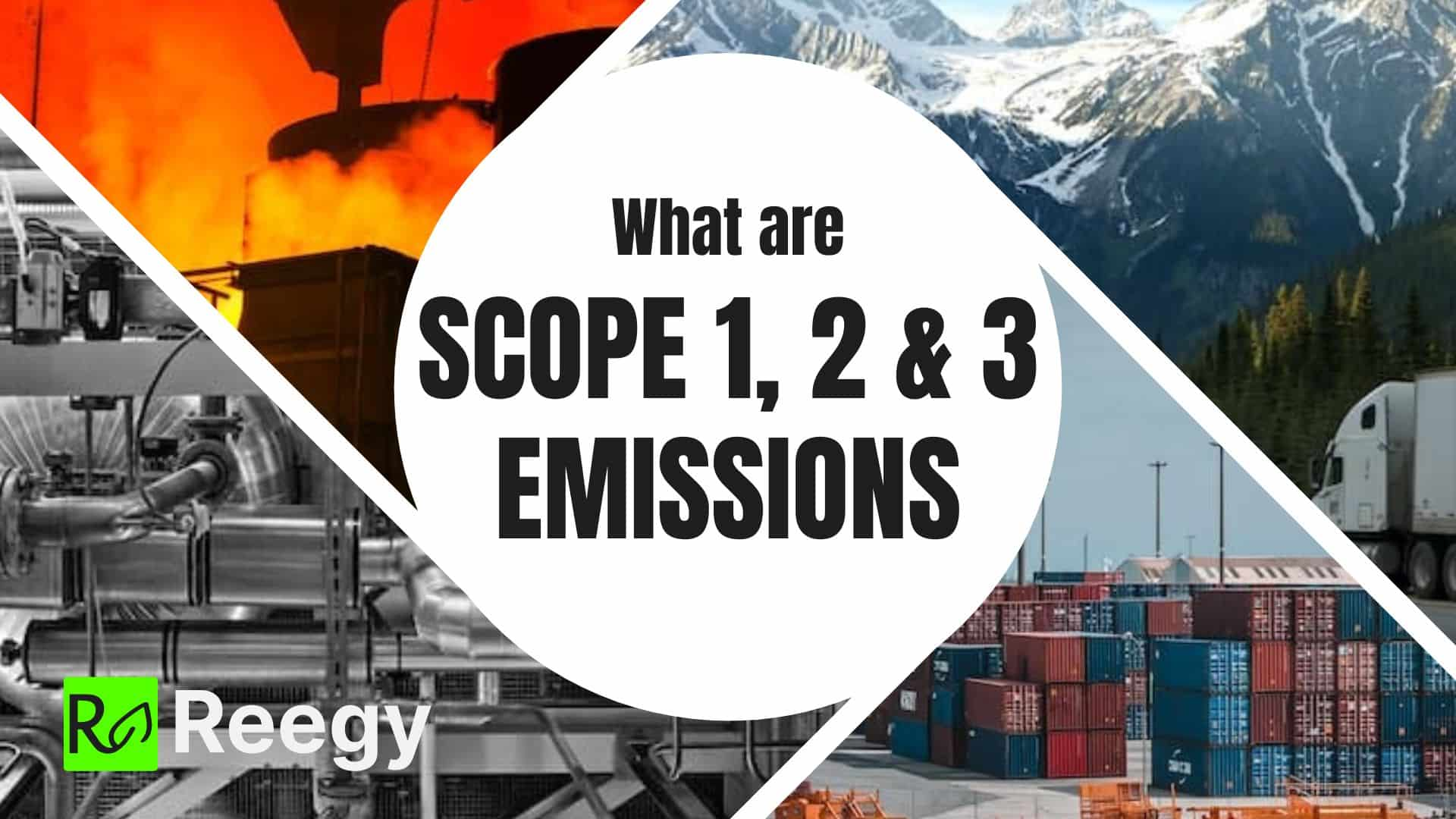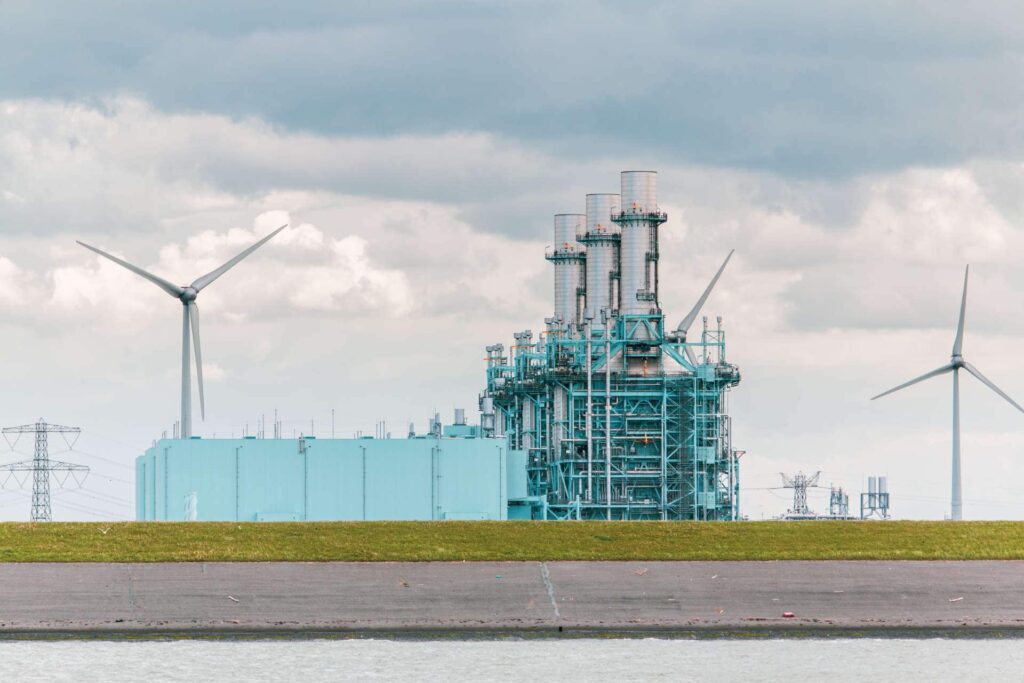
In carbon accounting, a company’s emissions are divided into scopes 1, 2, and 3 to differentiate between different direct and indirect sources along the value chain.
When starting your decarbonization journey to Net Zero, you will come across different types and sources of CO2 emissions.
It’s important to understand what they are, where they occur, and how to tackle them in an organization and this guide will answer all the questions you might have about them!
We will look at:
- What are scope 1, 2, and 3 emissions?
- Why are they important?
- How to measure scope 1, 2, and 3 effectively
What are GHG Scope 1, 2, and 3 Emissions?
The GHG Protocol classifies greenhouse gas emissions into three “scopes” which are accounted for and reported in a company’s emissions inventory. Scope 1 includes direct emissions from operations, scope 2 are indirect emissions from the generation of purchased energy, and scope 3 encompasses other indirect emissions occurring along the company’s value chain.
Greenhouse gases lead to negative impacts on our climate and must be reduced wherever possible to reduce global warming.
In order to quantify and compare emissions among industries, companies, and set reduction targets, carbon accounting, and reporting are two proven measures.
The GHG Protocol was the first to define a corporate standard on carbon accounting and proposed the three aforementioned scopes.
Scopes 1 and 2 must be disclosed in an organization’s GHG report and carbon inventory, while Scope 3 is optional.
However, in most cases, scope 3 emissions account for the majority of a company’s emissions and should not be neglected.
Due to the definition of scopes 1, 2, and 3 emissions, you should remember:
One company’s scope 1 is another company’s scope 2 and/or 3 emissions
Let’s go into more detail on each of the three scopes, how you can measure them and why you must know about them.
What are scope 1 emissions in carbon accounting?
Scope 1 includes all direct emissions from operations and resources an organization owns or controls. Examples are company activities such as the manufacturing of products or the fuel consumption of company vehicles.
Such emissions are largely a result of one of the following four types of activities:
Stationary Combustion
Stationary combustion stems from the generation of electricity, heat, or steam during company activities. Example sources are boilers, furnaces, turbines, as well as other heating sources and fuel.

Mobile Combustion
Mobile combustion occurs during the transportation of materials, products, waste, and employees in company-owned or controlled vehicles that burn fuel. This includes an organization’s fleet of trucks, cars, ships, airplanes, and buses.
The increasing adoption of electric cars and vehicles (EVs) leads to a shift toward allocating more emissions to Scope 2 (purchases of electricity, heat, and steam).
Process Emissions
Physical or chemical processing emissions are the result of the manufacture or processing of materials or chemicals. Examples are the manufacturing of steel, cement, aluminum, or waste processing.
Fugitive Emissions
Fugitive emissions are intentional or unintentional releases of greenhouse gases from seals, joints, or venting. Common causes are refrigeration or air conditioning units, or methane leakages from gas transport.
Combustion of biomass.
Direct CO2 emissions from the combustion of biomass are reported separately
Companies must account for and report all Scope 1 emissions in their inventory.
What are scope 2 emissions in carbon accounting?
Scope 2 emissions are indirect emissions from the generation of purchased electricity, heat, or steam consumed during a company’s operations. Emissions are reported using either a market-based approach or location-based average values.
Almost every company or organization uses electricity in their operations and only a few of them generate it themselves in on-site facilities.
Since electricity and other energy sources are often generated from coal and other fossil fuels, the energy sector has always been one of the largest emitters in the world. A company’s purchased energy is therefore included as indirect emissions in scope 2.
Transmission & Distribution Losses
Any losses of electricity through a transmission and distribution (T&D) system fall under scope 3.
Scope 2 emissions have traditionally been one of the largest sources of greenhouse gas emissions for organizations. However, as more utility providers around the world invest in renewable energy sources such as solar, wind, and water, scope 2 emissions are (luckily) on the decline.
This is not to say that they have completely vanished, however, and many energy-intensive operations and processes are still powered solely by fossil fuels.
Companies must account for and report all Scope 2 emissions in their inventory.

What are scope 3 emissions in carbon accounting?
Scope 3 emissions include all indirect GHG emissions along the value chain not included in scope 2 of the reporting company. They are linked to but not produced in its operations or happen due to the consumption of an organization’s products and services.
Scope 3 accounts for all upstream and downstream greenhouse gas emissions linked to a company’s operations that it does not produce on-site. Depending on the scale and product offering, these emissions can be significant and vastly exceed those from Scope 1 or 2.
Scope 3 emissions are voluntary to disclose in GHG reports, however, it is important to measure them if Net Zero is the goal of your company.
If you want to learn more about these impactful indirect emissions every company faces, read our ultimate guide to scope 3 GHG emissions.
The GHG Protocol proposes 15 categories to declare scope 3 emissions and each of them has different methodologies for measuring and analyzing data. Companies are free to use these categories as they apply to their operations.
Let’s look at each of these categories now:
Upstream Activities
Most upstream emissions are related to a company’s purchased or acquired goods and services which it uses to provide its own goods and services to customers. We also refer to them as cradle-to-gate emissions.
These activities also include business travel and employee commuting which can account for a significant chunk of indirect emissions.
Category 1 – Purchased Goods and Services
Emissions from the production of products purchased by the company, including tangible products and intangible ones like services.
Example: Emissions generated by a supplier to create motors which a manufacturer purchases to build and sell cars.
Category 2 – Capital goods
Physical assets used to manufacture a product, provide a service, or sell, store, and deliver goods and services.
Example: Assembly line equipment used to manufacture jet engines.
Category 3 – Fuel- and energy-related activities (not included in scope 1 or scope 2)
Any fuel and energy-related activities which are not covered by the other scopes. Most notably transmission and distribution (T&D) losses and generation of purchased electricity which is sold to end users.
Example: Mining of coal or extraction of natural gas for heating purposes
Category 4 – Upstream transportation and distribution
All emissions from transportation and distribution of products purchased by the reporting company from tier 1 suppliers. This includes transportation activities from air, rail, road, or marine transport.
Example: Shipping of steel pipes from a supplier to a company’s production facility using multiple carriers.
Category 5 – Waste generated in operations
Emissions generated from third-party disposal and treatment of waste, including recycling.
Example: Disposal of waste in a landfill which emits methane (CH4) and nitrous oxide (N2O).
Category 6 – Business travel
All business travel-related emissions in vehicles not owned or operated by the company.
Example: Taking an airliner and taxi to meet a client at their location.

Category 7 – Employee commuting
Emissions generated from transporting employees between their homes and work place.
Example: Emissions of the cars of all employees not owned by the company.
Category 8 – Upstream leased assets
Emissions from leased assets not accounted for in Scopes 1 and 2.
Example: Emissions from heated warehouse to temporarily store company goods.
Downstream Activities
Downstream emissions are indirect GHG emissions related to sold goods and services, including end-of-life treatment.
This includes all emissions from the distribution and usage of your sold products and services by the end user.
Category 9 – Downstream transportation and distribution
Emissions from vehicles used to transport and distribute goods and services not owned by the reporting company. This only applies to those transportation activities after the company has already sold and distributed its products, for example, those by an external marketplace.
Example: Emissions from the shipping provider an online marketplace uses to sell your product to their customers.
Category 10 – Processing of sold products
Emissions from further processing of a company’s sold goods to make final products.
Example: Emissions from the furniture manufacturer from the wood purchased by the reporting company
Category 11 – Use of sold products
The total expected lifetime emissions of the sold product by its end users including direct use-phase and indirect use-phase emissions.
Example: Fuel-related emissions from the car sold to an end-user or heating necessary to use pan for cooking.

Category 12 – End-of-life treatment of sold products
Emissions from disposal and treatment of products at the end of their life.
Example: Disposal of broken laptop in a scrap yard.
Category 13 – Downstream leased assets
Includes emissions from assets leased to others and not accounted for in Scopes 1 and 2.
Example: Emissions from a diesel truck a company leases to customers
Category 14 – Franchises
Emissions from franchises of a company not included in other scopes.
Example: Emissions from a restaurant as part of a food chain franchise.
Category 15 – Investments
Emissions from financial investments an organization has undertaken.
Example: Emissions from a renewable energy project a company has invested in.
Why should companies measure and disclose their GHG emissions?
In 2024, most enterprises and large organizations must follow regulatory obligations to disclose and offset their greenhouse gas emissions. However, reporting and reducing one’s carbon footprint also lowers climate-related costs, leads to greater brand loyalty, and increases stakeholder engagement.
Reduced Climate-Related Costs
Climate change presents many risks to humanity and the cost of not acting far exceeds those of implementing effective decarbonization strategies. Harvard Business Review found that 72% of businesses believe that they face severe risks to their operations and revenue due to climate change.
By making an impact now, you can help reduce those effects and achieve Net Zero in no time.
Transparency & Trust
Reporting and disclosing GHG emissions increase transparency and trust in your company. Customers have long cared about more than just the price tag of products and would rather spend their money on companies they trust.
Stand out among the crowd
Although 90% of executives think sustainability is important, Forbes found only 60% of them have a sustainability strategy in place.
By implementing sustainable business practices, reducing your carbon footprint, and taking climate action you can make your business stand out among your competitors.
Improved Stakeholder Engagement
61% of (institutional) investors and stakeholders examine ESG reports before investing and the number is rising.
Increased Brand Loyalty
It’s no secret that green products and companies are favored by consumers, especially among younger generations. As Deloitte found in its recent 2022 survey, this covers all aspects of ESG from reducing the carbon footprint to respecting human rights.
Investing in green tech and sustainability, therefore, yields a positive ROI and increases brand loyalty.
Greater Employee Satisfaction
Not only consumers care about the environment and a company’s footprint, but also its employees. In its 2021 consumer intelligence series survey PWC found that 84% of all employees would prefer to work for a company with strong environmental commitments.
Why is Measuring Scope 3 Emissions Difficult?
While companies can usually determine scope 1 and 2 emissions with relative ease, scope 3 emissions come in a variety of categories from a number of sources. This poses challenges in finding reliable data, accurate emission factors, and tracking outside data from suppliers and users.
Measuring scope 3 emissions can be a challenging task due to the amount of data necessary to calculate and report them.
Here are just a few steps an organization has to take to calculate its scope 3 GHG emissions inventory:
- Get accurate emissions data from suppliers on their scope 1 and 2 emissions
- Analyze employee commuting and business travel in the entire company
- Research the appropriate emission factors for each of the 15 categories in scope 3
- Measure and analyze the GHG emissions of each of their investments
- Turn all emissions into CO2 equivalents for reporting
- Create a detailed GHG emissions report
- …
As you can see, scope 3 reporting can be daunting and if certain factors change, it needs to be done all over again.
As we will see next, carbon footprint management software can help take the complexity out of GHG reporting and help in finding effective reduction strategies.
How Can Organizations Measure Scope 1, 2, and 3 Emissions?
Carbon Footprint Management solutions or climate action and carbon accounting platforms can significantly reduce the effort needed to measure, analyze, and report GHG emissions.
More importantly, they aid in finding potential reduction strategies and let you focus on the core aspect of carbon accounting: Reduce your overall carbon footprint and take meaningful climate action!
Reegy’s Software-as-a-Service solutions allow detailed scope 1, 2, and 3 emissions tracking, and our advanced AI can propose different reduction strategies based on your decarbonization targets.
Reegy is a complete software solution for ESG & Carbon Footprint Management. Our Reegy Eco Hub enables enterprises, financial institutions and governmental organizations to manage their climate action in one central location along the entire value chain. Track, measure, reduce, and offset your carbon emissions, disclose them to regulators, stakeholders, and customers and lead your company to Net Zero on autopilot!